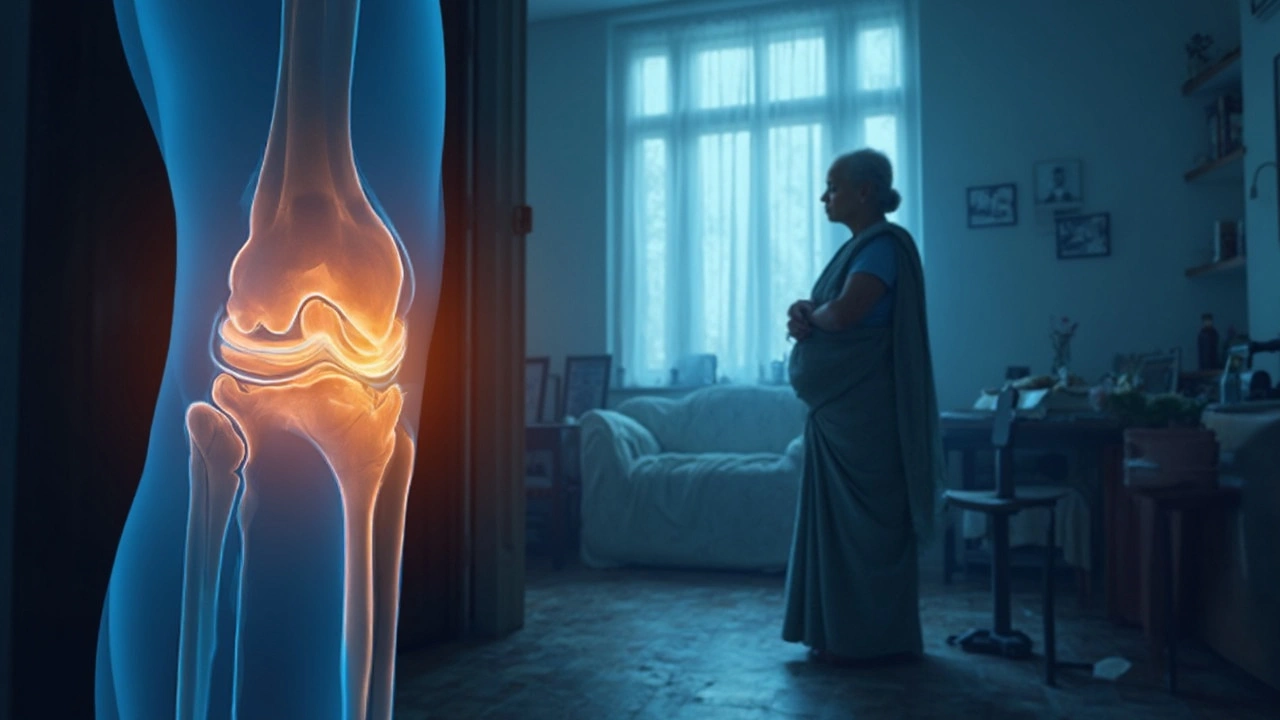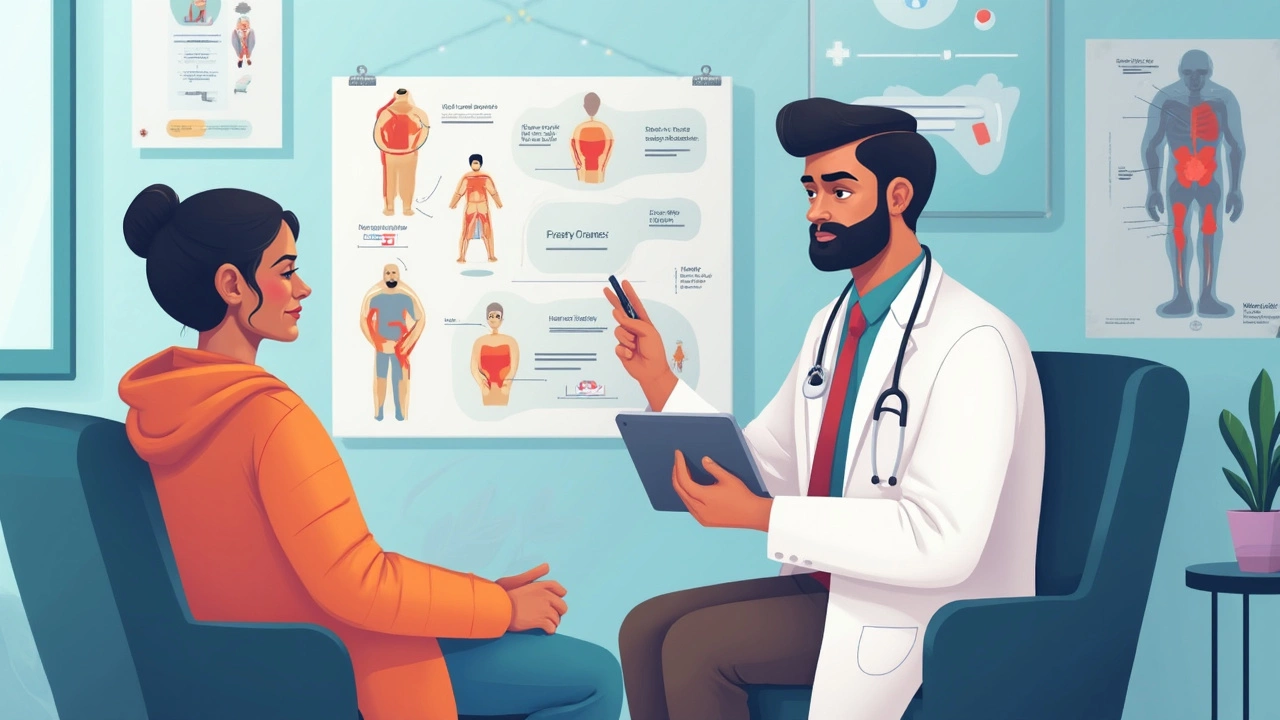Hearing that you're "bone-on-bone" in your knee can sound like a total sentence—like the next stop is metal and plastic in your leg. It’s a scary image, but does it mean you have to jump straight to surgery? The answer isn’t as simple as it sounds.
Plenty of folks are walking around with X-rays that look rough, but they're not all lined up at the hospital for knee replacements. Surgery is just one option. Before you decide, it's good to know the facts, what else might help, and when it’s worth holding off.
Let’s talk straight about what bone-on-bone actually means, why you feel the pain you do, and tips that can help even when things look pretty worn out. There's more hope than you might think.
- What Does Bone-on-Bone Actually Mean?
- When Is Knee Replacement Really Needed?
- Alternatives to Knee Replacement
- Real-Life Ways to Reduce Pain
- How to Decide What’s Best for You
What Does Bone-on-Bone Actually Mean?
When a doctor says your knee is “bone-on-bone,” they’re talking about the cartilage in your knee joint. Cartilage is the smooth, rubbery tissue that cushions the bones and lets them glide over each other when you bend or straighten your leg. Over time, this cartilage can break down because of wear and tear—mostly from osteoarthritis. Once it’s gone, the bones can literally rub against each other, and that’s what shows up on X-rays.
This grinding hurts because bones aren’t meant to touch like that. You might notice swelling, stiffness, noises like clicks or pops, and pain that can make walking or even standing tough. But here’s the curveball: the “bone-on-bone” label on an X-ray doesn’t always match how much pain you feel. Some people with nasty-looking X-rays feel okay, while others with mild joint changes struggle a lot.
Take a look at how cartilage loss stacks up with age, according to published joint health data:
| Age Group | % with Severe Cartilage Loss |
|---|---|
| 40-49 | 8% |
| 50-59 | 19% |
| 60-69 | 37% |
| 70+ | 49% |
The numbers explain why this “bone-on-bone” call gets more common as we age. It’s not rare. Most people over 60 will have some cartilage thinning or loss—though not everyone needs a new knee right away.
The key takeaway is this: an X-ray alone shouldn’t decide your next step. Your symptoms, lifestyle, and activity goals matter just as much as what the scan shows. Don’t feel locked into treatment just because your X-ray looks bad.
When Is Knee Replacement Really Needed?
Your knee is screaming most days, but does that automatically mean it’s time for surgery? Not really. Just because your X-ray shows bone-on-bone doesn’t mean you need a new knee right now. Docs usually look at more than just the scan—they want to know how your life is getting affected.
Think about it this way: if you’ve tried all the usual stuff (pain pills, physical therapy, braces, even shots) and you still can’t walk to your mailbox, that’s when the discussion gets real. It’s about what you can do, not just what the X-ray shows. Some people with ugly X-rays still get by, while others with less damage are totally stuck.
Doctors usually keep an eye on a few big points before talking surgery:
- The pain is so bad it messes with your sleep or mood.
- Walking, climbing stairs, or just getting around is a major struggle.
- You can’t do stuff you love, like playing with your grandkids or working.
- Other treatments just aren’t cutting it anymore.
Here’s a quick look at what research shows about people who end up getting a knee replacement:
| Reason for Surgery | Percentage of Patients |
|---|---|
| Severe daily pain | About 90% |
| Mobility problems | Roughly 80% |
| Failed other treatments | Over 95% |
So the bottom line? Surgery is mostly for folks whose lives are on pause, not just people with scary-sounding scans. If you’re getting by and the pain isn’t wrecking your day, you might be able to hold off much longer than you think.

Alternatives to Knee Replacement
If you’ve been told your knee is bone-on-bone, it’s easy to think a knee replacement is your only ticket out. But a lot of people never get surgery and still manage pain and keep moving. There are real options to try first, and for some folks, these work well enough to put off or even avoid replacement for years.
- Physical therapy: Not just basic stretches you find online. Real, targeted therapy can train the muscles around your knee to work better, take some load off that joint, and help you walk more comfortably. Even folks with severe arthritis see improvement, especially if they stick with it for months.
- Weight loss: Every pound you lose takes about 4 pounds off your knee joints with each step. So dropping 10 pounds means 40 pounds less force grinding that joint with every step—huge difference.
- Injections: Cortisone shots can cut inflammation and pain for weeks or even a few months. There’s also hyaluronic acid injections (gel shots), which some patients report helps them move better, although studies say the results are hit or miss.
- Medications: Over-the-counter pain meds like acetaminophen or ibuprofen are common. There are also prescription-strength versions. Doctors are careful with long-term use but these can help when other things just aren’t enough.
- Braces and supports: Some people get big relief just by using a good-quality knee brace. These unload the painful area and add stability.
There’s also less common stuff—like platelet-rich plasma injections (PRP) and stem cell therapies. The science on these is still early, with some studies showing benefits and others not so much. Insurance rarely covers them, but a few high-profile athletes and everyday folks alike have tried these paths.
| Alternative | Success Rate (Typical) | How Long Relief Lasts |
|---|---|---|
| Physical Therapy | 60-70% report improvement | Months to years (if continued) |
| Cortisone Injection | 50-70% get temporary pain relief | Weeks to 3 months |
| Hyaluronic Acid Injection | 30-50% get some benefit | Up to 6 months |
| Knee Brace | 40-60% report less pain | While brace is worn |
| Weight Loss | Helps with pain for almost everyone | Long-term (if weight is maintained) |
Just remember, your knee didn’t become bone-on-bone overnight. Often, these options buy you more comfortable years before you even need to talk about surgery again.
Real-Life Ways to Reduce Pain
If you’re dealing with a knee that’s bone-on-bone, pain management becomes a whole new daily project. Good news—there are concrete, real-world strategies that actually help, and you don’t have to be a gym rat or a pain expert to benefit from them.
The first thing most doctors push? Movement. No, you’re not training for a marathon, but you don’t want to freeze up either. Even small tweaks can keep your joint working better. For example, doing simple stretches for your hamstring and calf every day can take the edge off stiffness. Pool exercises are a game changer too—water keeps pressure off your knee while you build up strength.
- Knee replacement is often seen as the end cure, but regular use of ice packs, heat pads, or even switching them up can lower soreness, especially after a busy day.
- Losing just 5-10% of your body weight takes serious stress off your knee. This isn’t about “dieting,” it’s about helping your joint carry less.
- Shoes with cushy soles and good support matter way more than you might guess. Old sneakers might be making things worse, especially on hard floors.
- A real-deal physical therapist is worth the time, even if you’re stubborn or skeptical. They teach you muscle tricks so your knee isn’t doing all the work every time you stand or walk.
Don’t forget simple bracing. A knee sleeve or brace from your local shop adds stability, especially for going out or standing a lot. Some people try glucoasmine or turmeric; the research isn’t crystal clear, but if it works for you and doesn’t hurt, go for it. Topical pain creams (like those with capsaicin) can help with minor aches too.
If you’re still struggling, your doc might offer gel shots or corticosteroid injections. These don’t rebuild your knee, but they can give a pain break—sometimes for months. Just don’t expect magic. At the end of the day, mixing up a few of these tricks is better than betting on just one.

How to Decide What’s Best for You
This is where things get real personal. What works for your neighbor—or even your twin—might not be what you need. Deciding on a knee replacement, or if you can avoid it, comes down to your pain, your life, and your own goals.
Your doctor will probably look at a mix of things like your pain level, how much it stops you from getting around, and how much you’re willing to try other options first. You don’t have to be “bone-on-bone” on an X-ray to need a new knee, and just having terrible-looking images doesn’t always mean you need surgery right away.
Think about these questions before making a decision:
- How much is the pain messing up your daily life—like walking, sleeping, or doing basic stuff?
- Have painkillers, injections, or physical therapy stopped working for you?
- Do you want to avoid major surgery and are you willing to try everything else first?
- How’s your overall health? High risk or other health problems could change what’s safe for you.
Your doctor might also check physical stuff, like how bent or stiff your knee is, not just how your X-ray looks. According to recent hospital data, about 90% of people who get a knee replacement have major pain relief, but about 10% still report some pain or problems after surgery. It’s a big deal, so it’s worth weighing your options carefully.
| Factor | Why It Matters |
|---|---|
| Pain Severity | High pain that limits daily life pushes more toward surgery |
| Impact on Activities | Struggles with basics (stairs, walking, sleeping) |
| Tried Nonsurgical Options | Exhausting physical therapy, medications, injections |
| Health Risks | Other conditions (like heart or lung problems) might make surgery risky |
When it comes down to it, the most important signal isn’t just how your knee replacement looks on a scan—it’s what you feel doing the stuff that matters to you. If you can manage your pain and get through your day, there’s no rule you have to rush to surgery. But if every step is a struggle and nothing else helps, you might find a knee replacement gives you your life back.

 Unveiling the World's Most Common Illness and Its Impact on Medical Tourism
Unveiling the World's Most Common Illness and Its Impact on Medical Tourism
 How Much Weight to Lose for Reversing Type 2 Diabetes?
How Much Weight to Lose for Reversing Type 2 Diabetes?
 Understanding How Quickly Herbal Supplements Take Effect in Your Body
Understanding How Quickly Herbal Supplements Take Effect in Your Body
 Surgery with the Longest Recovery Time: What You Need to Know
Surgery with the Longest Recovery Time: What You Need to Know
 Which Nationality Eats the Healthiest? A Global Look at Diet and Wellness
Which Nationality Eats the Healthiest? A Global Look at Diet and Wellness